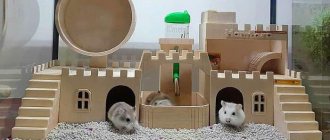When choosing a cage for your Syrian hamster, there are several factors to consider.
The most important thing when purchasing is to ensure that the cage you choose is large enough, safe and easy to clean. Unfortunately, many cages you find at the pet store do not meet all of these requirements when it comes to Syrian hamsters.
Cell type
You'll have to choose between a wire cage (usually with a plastic tray), a plastic modular cage (with lots of compartments and tubes), or an aquarium (with a secure mesh lid).
Each cage type has advantages and disadvantages in ease of cleaning, ventilation, and safety.
Easy to clean
In general, a wire cage with a plastic tray is easiest to clean. Simply remove the mesh top of the cage, clean the bedding and wipe down the wire part if necessary.
The more complex the cage, the more difficult it will be to clean, which is very important if you are considering a plastic cage with multiple compartments and tubes. These cages can be a real chore to clean.
Aquariums are not that difficult to clean, but they can be heavy and awkward to handle during cleaning.
How to make a cage for Djungarian hamsters with your own hands
If the purchased version of the cage is not suitable, you can try to make it yourself. However, having made such a decision, you should take into account that an ordinary jar, an old aquarium or a cardboard box will not be suitable for your future home.
Tools and materials
In the process of making a homemade cage for a dzhungarika you will need the following tools:
- marker for marking work;
- cutter for cutting holes;
- hot-melt gun with hot glue;
You should also stock up on a set of simple materials:
- food container;
- metal welded mesh, which is used when plastering facades - 4 pieces of a size equal to the sides of the container;
- plexiglass or ordinary window glass.
You will probably be interested in reading about what breed of pet hamster to choose, how long hamsters of different breeds live, and also learn how to train a hamster to respond to its name.
Step-by-step instruction
The process of making a cage for dzhungariks with your own hands is very simple and consists of several stages:
- Using a marker, mark lines on all sides of the container and lid along which the holes will be cut. The margin around the perimeter on all sides should be about 4–6 cm.
- Use a cutter to cut holes in the container along the marked line.
- Attach the metal mesh to three sides and the lid of the structure using a heat gun. In this case, the fastening of the parts is carried out from the outside of the container so that the hamster is not accidentally damaged by the edges of the mesh.
- Attach the glass to the remaining side using hot glue.
The hamster cage is ready for use. Its design features will make it easy to observe your pet through the glass, and also, due to the presence of a mesh, create a favorable atmosphere inside with constant access to fresh air.
Size
The cage size for a Syrian hamster must be at least 60x30 cm and at least 30 cm in height
However, to keep your hamster active and happy, try to get a larger cage - when it comes to hamster cages, bigger is better.
Syrian hamsters require plenty of space to run and play, and the actual cage area is important for this. In general, many rodent cages are too small for Syrian hamsters.
Please note that the chambers, compartments and built-in wheels of plastic modular cages may also be small for Syrian hamsters.
Features of keeping hamsters at home
You need to create conditions for your pet in which it will feel comfortable.
Microclimate
A rodent can get sick and die if it is kept in unsuitable conditions. Temperature changes can be detrimental for him. In the room where he lives, the thermometer should be within +20...+25 degrees. It is important to maintain a normal level of humidity in the room - 55-70%.
Even with good care, hamsters die early if kept in damp or drafty conditions. Small rodents have very weak immunity. Hypothermia can lead to the development of pneumonia. Overheating also leads to the death of the animal. For this reason, the hamster's cage should not be left in direct sunlight or near heating radiators.
When caring for a Syrian hamster, you should take into account that too bright lighting irritates the animal. In nature, rodents rarely see sunlight, because they leave their burrows only in the dark. For this reason, it is advisable to slightly shade the cage so that there is light twilight inside.
Cage selection and equipment
Pet stores have a large selection of cages for small rodents. These are single-level and multi-story structures with interesting content inside. However, when choosing a home for a pet, it is important to look not so much at the interior, but at whether it will be convenient for the owner to care for the animal.
Experts recommend keeping Syrian hamsters in metal mesh cages. This design is well ventilated, unlike an aquarium. When purchasing, you need to decide on the size of the cage. Since one animal will live in it - Syrians are not social - then a dwelling with sides of 50 x 30 or 50 x 35 cm is suitable.
The presence of a second level will allow you to gain more free space for the hamster.
Other cage requirements:
- The presence of a removable plastic tray makes maintenance more convenient.
- The distance between the bars of the grill should not exceed 1 cm.
- Tightly fitting and securely closing door at the bottom of the structure.
Interior arrangement
It will be easier to cope with caring for a rodent if you properly arrange the cage inside. You need to put the most necessary things there:
- Sleeping house - the hamster uses it as a hiding place.
- Feeder. Ideally, there should be two of them - one is filled with grain mixture, the other is used for wet food.
- Drinking bowl. To prevent the water container from taking up space in the cage and from tipping over, it is better to buy a nipple drinker. It is attached from the outside, and the spout from which the hamster drinks is turned inside.
- Running wheel. In nature, hamsters travel great distances in search of food, so they never suffer from obesity. Pet rodents also benefit from physical activity.
- Pipes, ladders. With their help, the animal can move from one floor to another.
- Toilet. Some hamster owners place a plastic container with sand or litter in the cage. But in most cases it turns out to be useless - the rodent chooses one corner in its home for these purposes. And even if you put a small tray there, the animal will begin to defecate in another place.
Attention! Caring for a rodent also means ensuring its safety. If the cage has a second tier, it is important to ensure that the hamster cannot fall from there. The injury may be fatal.
Filler
Caring for your Syrian hamster will be easier if you choose a good litter. Wood shavings and compressed sawdust are used as bedding. If the animal suffers from allergies, corn or cellulose filler is suitable. The litter should absorb moisture well and mask unpleasant odors.
Advice! When choosing wood filler, you should pay attention to the composition. If it contains softwood sawdust, it can cause allergies.
Caring for a hamster will become much more difficult if you use paper or pieces of fabric as bedding. These materials get wet quickly and do not retain foreign odors. Silica gel cannot be used as a filler. A Syrian hamster may accidentally ingest the pellets, causing an intestinal obstruction.
It is also not recommended to use newspapers - printing ink contains harmful substances.
Syrian hamster - feeding
Under natural conditions, rodents eat seeds of various plants, nuts, vegetables and herbs. The diet of a pet should be approximately the same. It is based on a grain mixture. Pet stores sell ready-made food for hamsters. The richer the mixture, the better.
The rodent's diet should include the following components:
- oats;
- buckwheat;
- barley;
- corn;
- wheat;
- sunflower seeds;
- peanut;
- raisin.
Your pet needs not only fiber and protein, but also vitamins. Therefore, you need to include vegetables in the menu: carrots, cucumbers, zucchini, bell peppers. In summer, the animal is given grass: dandelion leaves, plantain, alfalfa, sedge. In winter, fresh herbs are replaced with herbal pellets.
Attention! Hamsters continue to grow teeth throughout their lives, so their diet should include roughage: branches of fruit trees and shrubs.
To satisfy the animal's need for minerals, a salt lick stone is fixed in the cage. It is also necessary to ensure that the drinking bowl is always filled with clean water.
Anyone who is going to care for a hamster must remember what not to feed it. List of prohibited products:
- cabbage;
- citrus;
- sweets;
- cheese;
- potato;
- Red beetroot;
- sausage, frankfurters;
- snacks;
- milk;
- bread.
Breeding
Before you start breeding Syrian hamsters, you need to weigh everything. The owner of the pair must think in advance where to place the offspring. If he fails to find a new home for the small rodents, caring for them will fall on his shoulders.
Attention! Syrian hamsters are very fertile. There are 10-16 cubs in a female's litter.
Sexual maturity in these animals occurs early - at 1.5 months. Experts do not recommend crossing a female with a male at this age. The right time for the first pregnancy is 4-6 months. Individuals of different sexes are kept separately, otherwise they will fight for territory.
The female is placed with the male during estrus, which occurs every 4-5 days. After a short acquaintance, the Syrians mate. The couple is then separated.
Pregnancy in Syrian hamsters lasts 18 days. During this period, the female needs good care. She is placed in a spacious cage, because after giving birth she will have to share a home with her cubs for a month. The hamster is kept in a quiet, well-ventilated room.
Caring for small hamsters is not required; the female copes with all responsibilities herself. The main thing is not to disturb her, do not touch the cubs with your hands and provide the mother with adequate nutrition. In addition to grain, she needs vegetables, herbs, low-fat cottage cheese, and boiled poultry fillet. In just a month, the hamsters will become adults. Then they are separated from their mother and distributed to new owners.
Cage safety and protection
The distance between the bars in a Syrian hamster cage should be no more than 1 cm.
If the cage has horizontal bars, your hamster will enjoy climbing on them.
Check the doors of any cage to make sure they are securely closed, as hamsters can learn to open doors. Metal snap hooks, such as those on the end of a dog leash, can be attached to the door for added security against opening.
If you choose a cage with several levels, make sure that the hamster will not fall from a great height.
Which cage to choose for different breeds
Hamsters are not just rodents of the same type; they differ in breed, size, character traits, shades of fur and lifespan. At home, they mainly keep Dzungarian and Syrian representatives. Let's look at the most convenient designs for keeping hamsters of these two main breeds.
Djungarian hamsters
Djungarian hamsters are medium-sized animals, up to 10 cm in length. The pet's weight is about 65 g. They are nimble and mobile, they love free space and jogging. They often escape from their home.
For such a pet, you need to choose a spacious cage made of durable material with a secure lock. Space is important when equipping a structure; these representatives are of little interest in labyrinths between floors.
The recommended cage for a Djungarian hamster is a one-story structure with a deep tray measuring 30x30x45 cm with horizontal bars on which the pet will happily climb. The distance between the rods is no more than 5 mm, otherwise the hamster may escape from its home. The cage should be equipped with a resting house, a running wheel, as well as a drinking bowl and feeder.
Syrian hamsters
Syrian hamsters are larger in size. Adults reach 12-20 cm in length, and their weight can reach 100-140 g. Accordingly, the cage for such a pet should be large and cozy. The optimal size of the structure is 50x30 cm, height is at least 25 cm. If you purchase a 2-story cage, there must be at least 30 cm between floors.
The Syrian hamster's house should be spacious and equipped with everything necessary for normal life and play - a drinking bowl, feeder, ladders, a wheel, labyrinths, etc. Cramped housing will not allow the hamster to be active, which can cause serious health problems (obesity, physical inactivity, etc.), as well as shorten the life of a hamster.
Cages for Syrian hamsters and their tendency to chew everything
Hamsters' cravings and ability to chew on anything can influence cage choice.
Wire cages have many benefits, but some hamsters are almost obsessed with chewing on the bars of the cage. If providing enough teething toys and boredom relievers does not reduce this desire, switching to a plastic cage or aquarium may be a better option.
When choosing a plastic cage, make sure that there are no exposed edges or protrusions of plastic that could cause your hamster to chew on the cage and eventually escape.
Aquariums are generally not chewable (but make sure the lid is tightly closed).
Where to put the cage in the apartment
If there are other animals in the house, in addition to the hamster, it is recommended to place the cage with the animal in such a way that the house inhabitants cannot harm the fluffy one.
When choosing a place to live, you should pay attention to several important aspects:
- absence of drafts that can cause various colds;
- absence of direct sunlight, which causes overheating of the hamster’s body and deterioration of its health;
- presence of electrical and heating appliances nearby.
The cage should be located in a fairly quiet, secluded place where strong sounds and constant sunlight will not disturb the fluffy, especially during the daytime rest. To avoid the formation of debris around the home, you can place it inside a cardboard stand about 10 cm deep.
Read more about how to name a Djungarian hamster for a girl or a boy.











